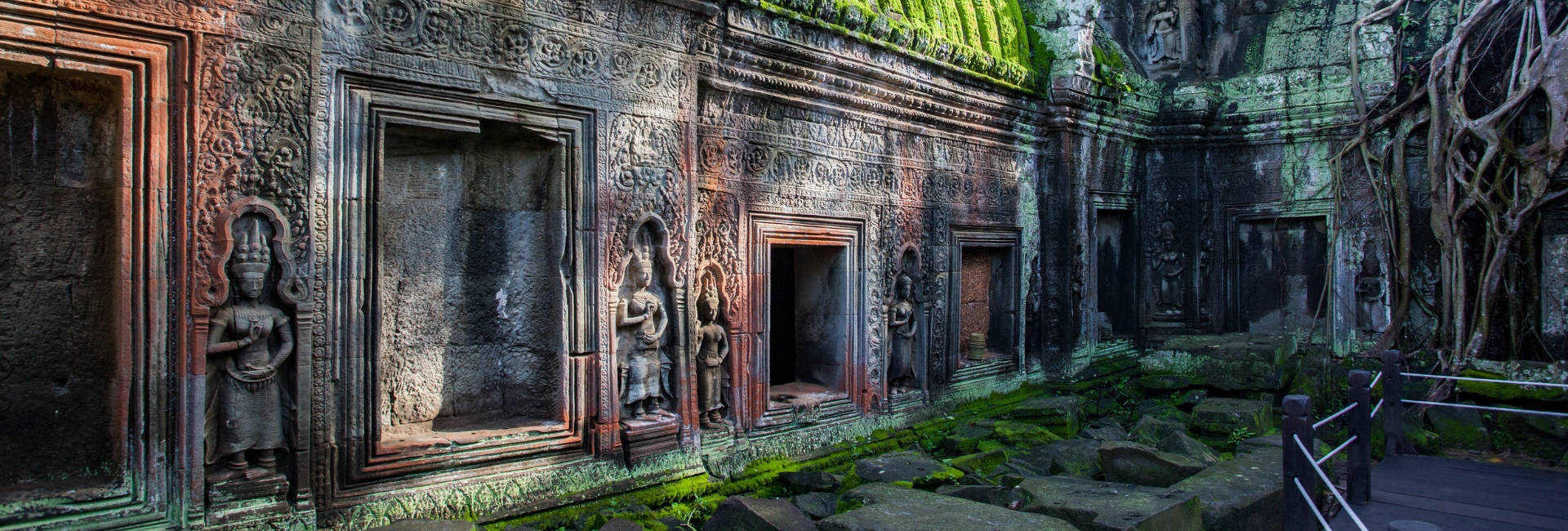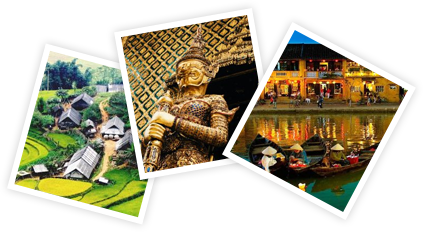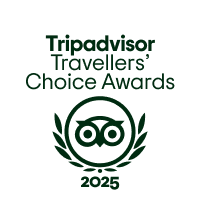Planning a 3-week journey to Vietnam is quite easy but it may be too much if in Cambodia due to this country being a bit smaller. It is really a perfect idea to believe that combining two places will maximize your use of your family holiday. This comprehensive travel guide and perfect itinerary will help you plan an unforgettable journey through the highlights of Vietnam and Cambodia. From the best time to visit, visa information, currency details, and a week-by-week itinerary, we’ve got you covered. Let’s dive in!
What can you expect 3 weeks in Vietnam and Cambodia?
Spending 3 weeks in Vietnam and Cambodia lets you experience the very best of both countries at a comfortable pace. Although they share a land border, flying between them is the most convenient and time-saving option.
With 3 weeks in Vietnam and Cambodia, you can take through bustling cities, ancient temples, and stunning landscapes. You’ll experience Hanoi’s street food scene, cruise through Ha Long Bay’s limestone karsts, explore Angkor Wat’s mystical temples, and navigate the Mekong Delta’s floating markets. Each destination offers unique cultural encounters, from cooking classes to temple visits, creating unforgettable memories.
You’ll find these countries perfect for both family adventures and active senior travel. Families can enjoy educational temple visits, gentle boat rides, and interactive cooking classes that engage children with new cultures. If you are active seniors will appreciate comfortable walking tours, scenic boat journeys, and well-paced itineraries that balance exploration with relaxation. The infrastructure accommodates all ages with air-conditioned transport and moderate activity levels.
Both countries share deep cultural roots and a complex history, including the wars of the 1970s. For an even broader perspective, you could extend your itinerary to include Laos, exploring how these Southeast Asian neighbors are linked through history, culture, and tradition.
>>> See tour: Far East Discovery 22 Days
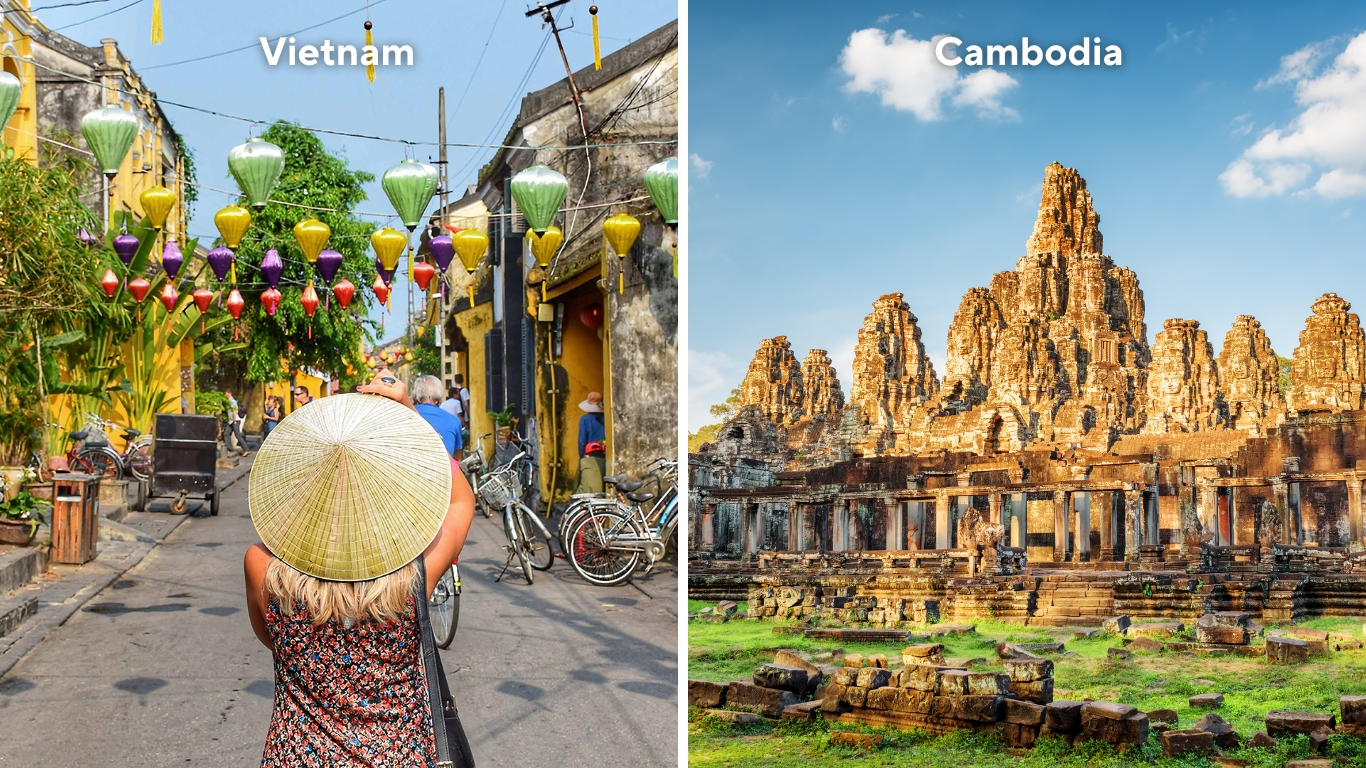
For travelers from North and Latin America, the journey to Vietnam and Cambodia is long, but well worth it. With so much to experience in 3 weeks in Vietnam and Cambodia, a private tour arranged by a trusted local agent ensures your trip is tailored to your preferences – from daily activities and accommodations to your ideal pace and private transfers.
When Is the Best Time to Visit Both Vietnam and Cambodia?
In general, the best time to visit both Vietnam and Cambodia is from October to March. However, it’s important to note some specific considerations for each month:
- October and November are the rainy season in Central Vietnam, so be prepared for occasional showers.
- December is winter in northern Vietnam, and it can get quite cold, especially in mountainous regions. The landscape may not be as vibrant, but you can still enjoy the cultural aspects and urban areas.
- January and February are the dry season in both Vietnam and Cambodia, offering pleasant weather for outdoor activities and sightseeing.
- March witnesses one of the most beautiful months for outstanding landscapes in Vietnam’s mountains. However, both Vietnam and Cambodia can be crowded during this time, and prices for flights and accommodations may be higher.
Ultimately, the best time to visit depends on your expectations and the availability of time for your journey. Consider your preferences for weather, crowd levels, and budget while planning your trip.
Perfect Itinerary for Highlights
To make the most of your trip, we suggest you an overall perfect itinerary that takes you through the highlights of both countries. Whether you’re captivated by ancient temples, stunning landscapes, or vibrant cities, this itinerary offers a well-rounded adventure. So, let’s dive into the details of each week:
Week 1: North Vietnam & Hue
- Day 1: Hanoi Arrival – Arrive in Vietnam’s capital and explore Hoan Kiem Lake area in the evening.
- Day 2: Hanoi City tour – Visit Ho Chi Minh Mausoleum, Temple of Literature, and explore the Old Quarter’s bustling streets.
- Day 3: Hanoi – Ninh Binh – Boat through Trang An’s caves and limestone formations, climb Mua Cave for panoramic views
- Day 4: Ninh Binh – Halong Bay – Cycling through rural villages and rice paddies in the morning then transfer to Halong Bay. Overnight on cruise.
- Day 5: Halong Bay – Hanoi – Enjoy your free time by visiting hidden coffee, then take a Hanoi street food with a local guided to sampling pho and local delicacies.
- Day 6: Hanoi – Fly to Hue – After arriving Hue, explore the Imperial City complex, Forbidden Purple City, and royal tombs of Vietnamese emperors.
- Day 7: Hue City tour – Take a morning boat along the beautiful Huong River to see the Thien Mu Pagoda, one of Vietnam’s oldest Buddhist sites, and Thuy Bieu village, which features a calm garden house, historic temples, and homes where people make incense.
Special Travel tips: Above is the brief itinerary for your first week in Vietnam. Whether you’re traveling with family or you’re an active senior seeking lively experiences, Hanoi offers plenty of ways to dive in. You can explore the Old Quarter on a motorbike or opt for a jeep tour for a more comfortable ride, taste unique street food on an evening tour while soaking up the city’s vibrant energy, and glide through Trang An’s cave system like an adventurer in a film.
If you’re up for a bit challenge – suitable for active seniors and children over 12 – climb the 400+ steps to Mua Cave for a breathtaking sunset view. Prefer something easier? Visit Thien Ha Cave instead, where you can explore both water and dry caves with equally stunning scenery, minus the steep climb.
For families, Halong Bay’s cruise ships provide safe exploration with shallow water activities, while Hue’s imperial sites offer educational value through well-preserved architecture and royal artifacts,while Hue’s imperial sites offer educational value through well-preserved architecture and royal artifacts. If you are active senior travelers, the Halong Bay cruise offers comfortable deck viewing of scenery without physical demands, and Hue’s dragon boat rides along the Perfume River provide cultural immersion with minimal walking.
>>> Read more: Beyond the Ordinaries of Vietnam: 10+ Unusual Things to Do in Hue
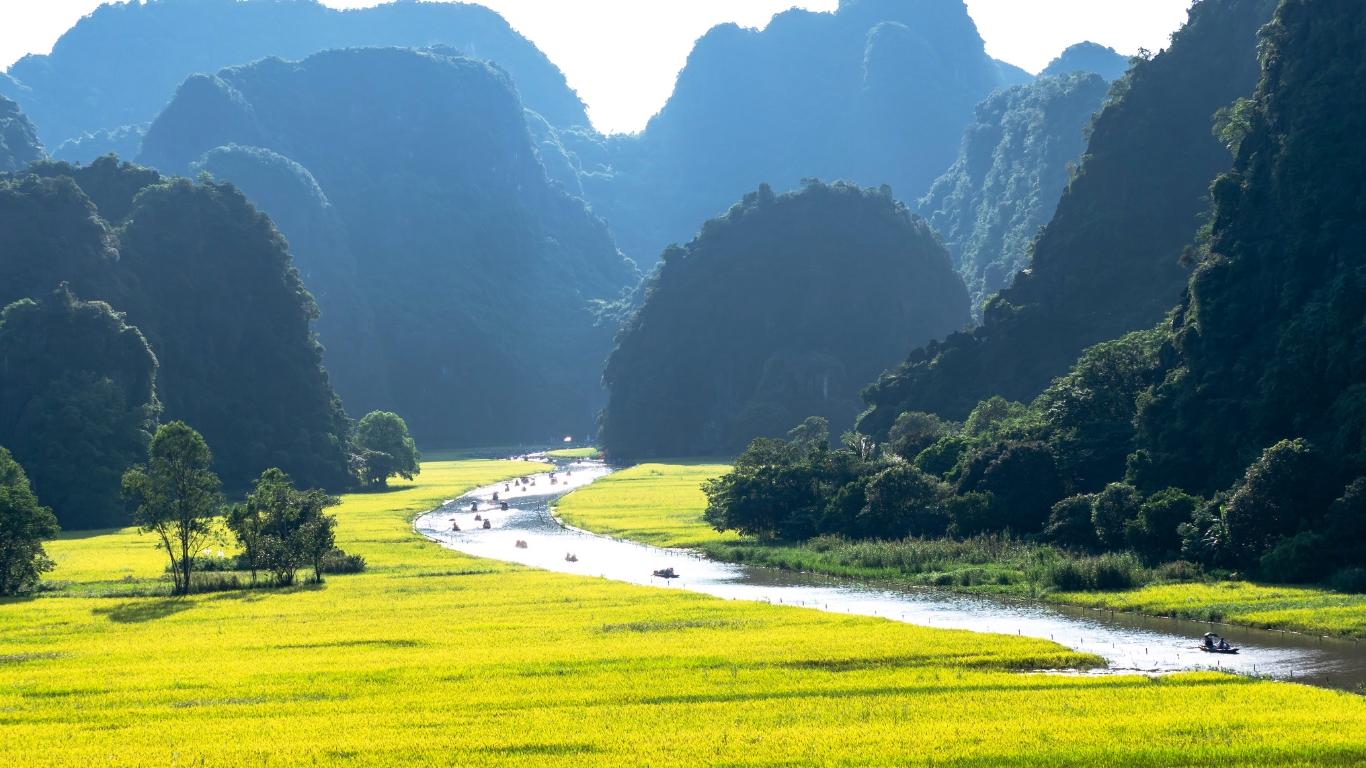
Week 2: Central & South Vietnam
- Day 8: Hue – Drive through Da Nang to get to Hoi An – Travel south via scenic Hai Van Pass, stop at Marble Mountain caves, arrive in lantern-lit Hoi An.
- Day 9: Hoi An ancient town walking tour – Morning walk through ancient streets, cycling through villages nearby then do market tour followed by hands-on cooking class. You can enjoy coffee and do some tailor made clothes.
- Day 10: Hoi An leisure day – Relax in An Bang beach.
- Day 11: Hoi An free time – Drive to Da Nang – Fly to Ho Chi Minh City – Afternoon flight to Vietnam’s bustling southern metropolis, evening street food tour by Vespa.
- Day 12: Ho Chi Minh City – Cao Dai – Cu Chi tunnels – Morning visit to the historic Cu Chi tunnel system, afternoon exploring the city’s French colonial architecture.
- Day 13: Ho Chi Minh City – Boarding Cai Be – Can Tho – You will be picked-up at the hotel in Saigon then travel to the Mekong Delta for an overnight cruise through Vietnam’s rice basket region.
- Day 14: Can Tho – Chau Doc – Early morning floating market visit, then continue to the border town of Chau Doc.
Special travel tips: On Day 13, you should consider taking a Mekong cruise from Vietnam to Cambodia overland – it’s a more scenic journey and can be more budget-friendly than flying.
For families, Hoi An’s flat ancient streets are perfect for walking with children, while cooking classes engage all ages in hands-on cultural learning. An Bang Beach provides safe swimming conditions, and the Cu Chi tunnels offer educational historical experiences with wider sections suitable for children.
If you are active senior travelers, the scenic Hai Van Pass drive provides stunning coastal views without walking, and Hoi An’s bicycle tours can be customized to comfortable distances. The Mekong Delta cruise includes comfortable seating areas with minimal walking required, and you can choose your level of Cu Chi tunnel exploration with informative above-ground exhibits available as alternatives to crawling through narrow underground passages.
>>> See private tour: Southern Vietnam Discovery 6 Days
Week 3: Phnom Penh & Siem Reap
- Day 15: Speed boat from Chau Doc – Phnom Penh – Cross the border via scenic Mekong River speed boat journey to Cambodia’s bustling capital city.
- Day 16: Phnom Penh – Visit National Museum’s, late afternoon visit Toul Sleng Prison Museum and the Choeung Ek Killing Fields to learn more about Cambodia’s brutal past under the Khmer Rouge government.
- Day 17: Phnom Penh – Drive to Siem Reap – Visit Ta Prohm then take a tour on Ton Le Sap Lake in the late afternoon.
- Day 18: Siem Reap -Angkor Wat and Angkor Thom complex. In the afternoon, we’ll take a Tuk Tuk to explore Siem Reap’s suburbs before visiting the Artisan D’Angkor workshop.
- Day 19: Siem Reap – Free time – Leisure day for additional temple visits, spa treatments, or souvenir shopping in local markets.
- Day 20: Depature – Final shopping and departure completing your 3 weeks in Vietnam and Cambodia adventure.
>>> Check the estimated rates & accommodations of Splendors Of Vietnam & Cambodia 17 Days
Special travel tips: Your final week completes your 3 weeks in Vietnam and Cambodia journey with Cambodia’s most iconic destinations. For families, the Angkor temple complex provides educational value through well-preserved Khmer architecture, while the National Museum offers interactive displays about Cambodian culture that engage children. The floating village tours on Ton Le Sap create magical memories as you observe unique water-based communities.
If you are active senior travelers, Angkor Wat and Angkor Thom require moderate walking on ancient stone pathways, but you can hire electric carts for transportation between distant temple sections. The Phnom Penh museums provide air-conditioned comfort with plenty of seating areas, and tuk-tuk rides offer authentic transportation without walking demands. For those wanting to skip the intense history museums, you can spend extra time exploring the Royal Palace’s beautiful gardens and silver pagoda instead.
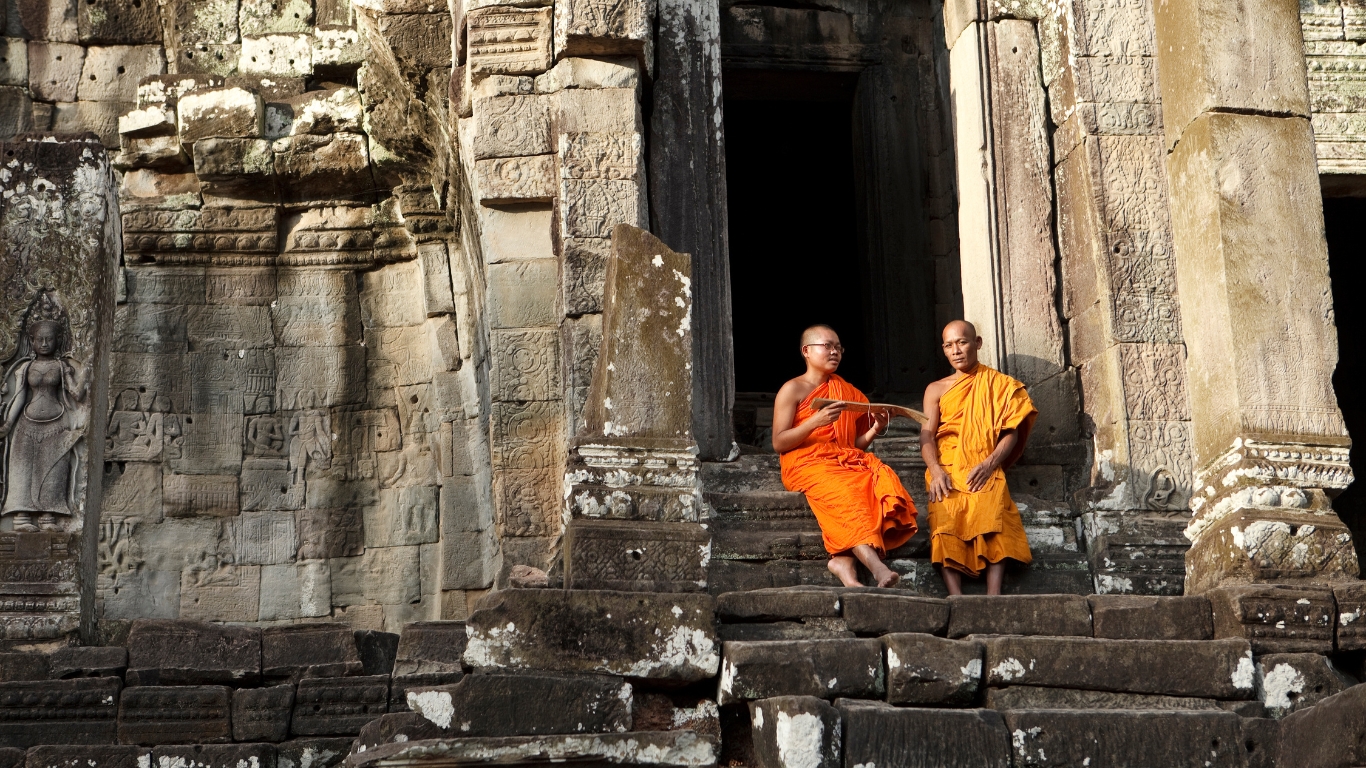
However, the above is just an overall suggestion for a perfect Vietnam and Cambodia highlight itinerary, for the other specific requirements such as interest in locals, nature or culture, etc. You can absolutely share with our travel consultant and customize your trip. You can take more trip ideas at our list of Vietnam and Cambodia tours.
Vietnam and Cambodia Visa
Cambodia is one of the few countries that have straightforward visa rules, which is quite convenient for travelers. Unless your passport is from Southeast Asia (which receives a free visa), you only need to apply for an e-visa online or get a visa upon arrival.
Foreign visitors to Vietnam can also apply for an e-visa online, which is valid for 30 to 90 days. A 30-day e-visa cannot be renewed, but a visa on arrival for 30 to 90 days can be extended.
The visa fee ranges from $25 to $35, depending on the entry port, and the visa is valid for 30 days. When applying online, ensure that you have the correct dates, your flight number, port of entry, a digital passport photo, a bank card for payment, the address of your first hotel, and personal information.
The processing time typically takes between 3 to 7 business days, excluding weekends. So, if you submit your application on a Friday afternoon, you might have to wait until the following Friday. However, if you submit it on Monday, you should receive your e-visa before the end of the week.
For the rest of the world, except Africa, the Middle East, and some South Asian countries, it is necessary to apply for a visa in advance. However, most countries in Latin America, North America, Europe, Central Asia, and Oceania can apply for a 30-day e-visa.
Currency
When visiting Vietnam and Cambodia, it’s recommended to carry a mix of US dollars and local currency for convenience. Be sure to have small denominations for easier transactions and to negotiate better prices in local markets.
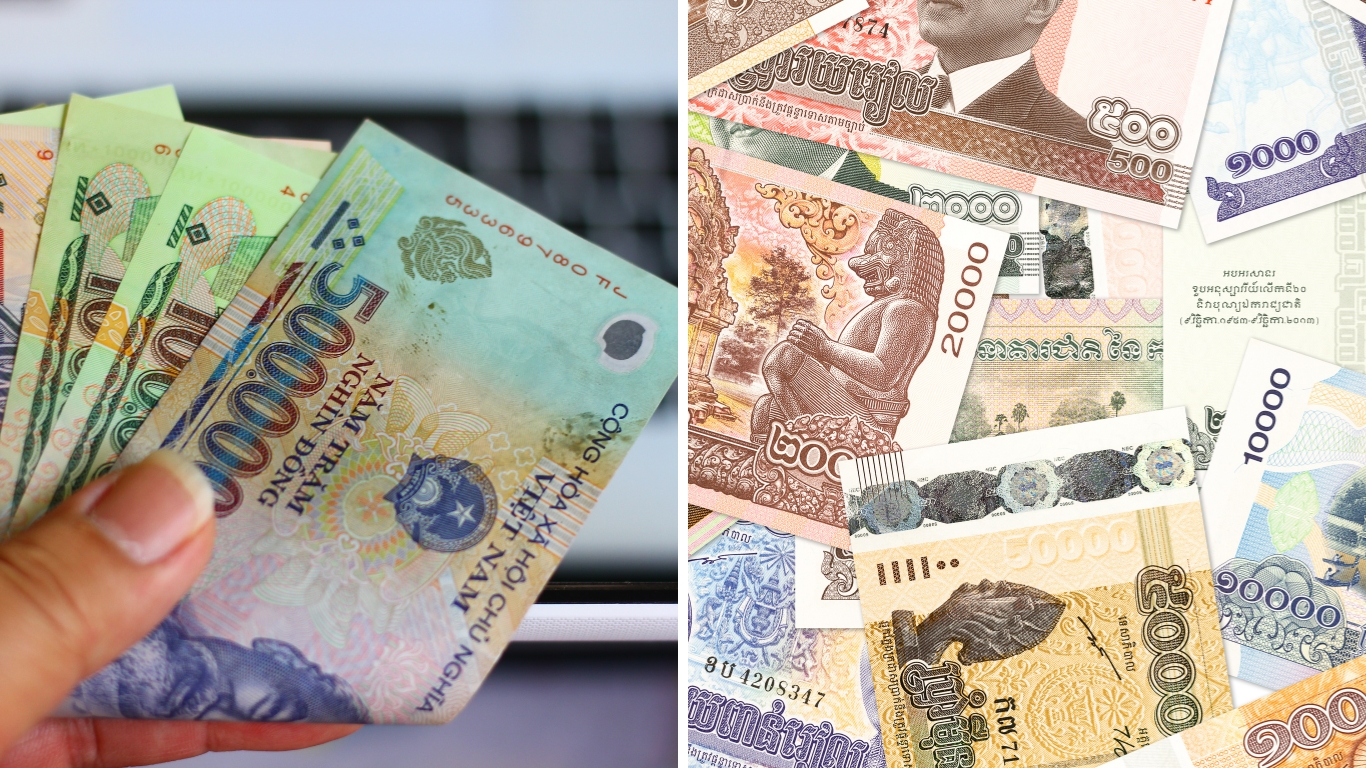
Vietnam
In Vietnam, the official currency is the Vietnamese Dong (VND). Cash is widely accepted, and ATMs are readily available in major cities and tourist areas. Credit cards are also accepted in many hotels, restaurants, and shops, but it’s advisable to carry some cash for smaller establishments and markets.
Cambodia
Similarly, in Cambodia, the official currency is the Cambodian Riel (KHR). However, the US dollar is widely accepted and preferred for most transactions. ATMs are widely available in cities, and credit cards are accepted in many hotels, restaurants, and larger establishments.
Vietnam and Cambodia Electricity Information
When planning your visit to Vietnam and Cambodia, it’s essential to be aware of the electricity information, including the voltage and power plug types in each country.
Vietnam
- The standard voltage: 220V
- Primarily uses two types of power plugs: Type A (the most common), which consists of two flat pins and Type C, which features two round pins.
>>> FYI: Electricity in Vietnam: What you need to know before your journey
Cambodia
- The standard voltage: 230V
- Primarily uses two types of power plugs: Type A (the most common), which consists of two flat pins and Type C, which features two round pins. (However, type G outlets with three rectangular pins are becoming more prevalent in modern establishments).
It’s important to check the power requirements of your electronic devices before your trip. Many modern devices can handle a wide voltage range (usually 100V-240V) and automatically adapt to the local voltage. However, some devices may require a voltage converter to operate correctly.
By bringing a suitable travel adapter and considering the voltage compatibility of your electronic devices, you can easily charge your devices and navigate the electrical systems in Cambodia without any issues.
FAQs
How many days are enough for Vietnam and Cambodia?
The ideal duration for a combined trip to Vietnam and Cambodia depends on your interests and the places you wish to explore. Generally, a minimum of 10-14 days is recommended to have a meaningful experience in each country. However, if you want to cover more destinations and have a more immersive experience, allocating around 2-3 weeks would be preferable.
>>> Read more: 3 Ideas for Vietnam and Cambodia Itinerary – How Long to Stay?
Is 3 weeks too long for Vietnam?
No, 3 weeks is not too long for Vietnam. Vietnam is a diverse country with a rich cultural heritage, stunning landscapes, and numerous attractions to explore. Within 3 weeks, you’ll have ample time to visit various regions, experience the local culture, enjoy different activities, and immerse yourself in the beauty of the country. It allows for a more relaxed pace of travel and the opportunity to delve deeper into each destination.
How much money do you need for 3 weeks in Vietnam?
The cost of a 3-week trip to Vietnam can vary depending on various factors such as your travel style, accommodation choices, dining preferences, and activities. As a general guideline, a moderate-budget traveler can expect to spend around $50-70 per day on accommodations, food, transportation, and sightseeing.
This estimate can increase if you prefer luxurious accommodations, fine dining, or additional activities. Including flights and other pre-trip expenses, a rough estimate for a 3-week trip to Vietnam would be around $1500-2500 per person.
For over 15 years, Indochina Voyages has specialized in creating private, customized tours in Vietnam and throughout Indochina for travelers from around the world. We offer special private tours just for you, so your itinerary is customizable to match your travel needs. Share with us your travel interest and get the quote by filling in this form or email at [email protected].
As your comfort are our top priority, that’s why prompt responses, professionalism, and keeping in touch your journey are one of our core values. If you are worried and unsure who we are, no words are better than reading our 590+ EXCELLENT REVIEWS ON TRIP ADVISOR.

